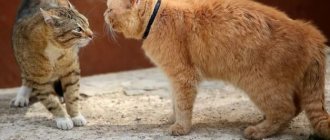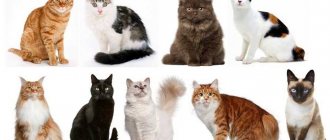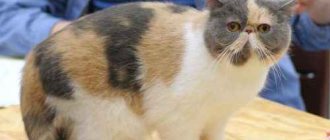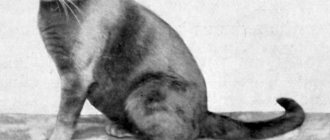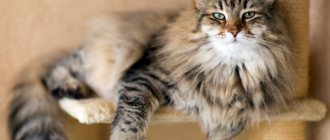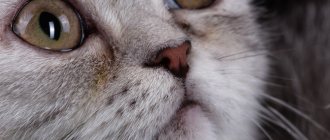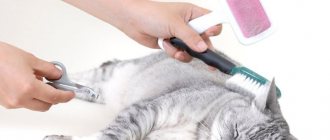Shedding in a cat is one of the most important problems that a person who does not know the characteristics of the cat’s body, character, cat breed, etc. may encounter.
You don't always need to sound the alarm when you notice that your cat has begun to shed heavily.
In this article we will consider such important issues as:
- What is the molting process?
- Why does a cat shed? (causes)
- Kittens' first molt
- Shedding periods in adult cats
- What to do if your cat sheds a lot? (medicines and grooming)
- Anti-shedding food
- What cat breeds don't shed?
- How we deal with our cat's shedding (advice from experienced people)
Why and how cats shed
Shedding in cats is a natural, regular process of changing coat. Shedding in animals happens for different reasons and at different times.
Shedding is a common occurrence in cats.
Seasonal
In a normal situation, a cat sheds twice a year:
- the beginning of cold weather. The transition to the winter season is signaled by a decrease in daylight hours, a decrease in temperature, and this turns on protective mechanisms in animals. Cats quickly grow new fur to keep them warmer in cold weather.
- onset of heat. In summer, the hair grows lighter so that it does not get hot.
Cats who roam freely react the most to the change of season. Their body senses weather changes more strongly and reacts more sensitively.
Pets that are not allowed outside also shed, but regardless of natural conditions. Shedding occurs once or twice a year.
Seasonal molting lasts about a couple of weeks to two months. If the shedding continues, you should contact your veterinarian.
According to breed characteristics
In cats with long, thick fur, this process occurs much more noticeably.
Mustaches are divided into 4 types:
- long-haired;
- semi-longhaired;
- short-haired;
- hairless.
The shorter the coat and thinner the undercoat, the less problems with shedding.
Functions of the coat
Different hairs on cats have different functions. Topcoat hair covers the undercoat and skin. The sebaceous glands approach their base. Their secret prevents the wool from getting wet. In some breeds, the wool has a very high water-repellent effect, in others this ability is lower.
Downy hair forms a thermoregulating layer - it prevents the body from cooling down and overheating. The underpad also protects the surface of the skin from cracking, drying out, and damage. Wild cats, forced to wade through bushes for prey, have a denser undercoat. Through it, thorns and twigs cannot reach the delicate skin of the animal.
In addition, the pigment in the fur with a “wild” color allows the animal to merge with the surrounding landscape. Anyone who decides to get a pet that does not cause problems with shedding - hairless cats - is faced with the problem of caring for the pet's sensitive and delicate skin.
Hair also includes vibrissae - hard, long hairs located on the pads on the sides of the nose, above the eyes, on the lower jaw, and the back of the paws. Their length varies from 6 to 8-9 cm. Vibrissae are organs of mechanical sensitivity (tactile function).
A cat, having lost its fur coat along with whiskers and sensitive hairs on the body, loses confidence in movement. These hairs help determine the distance to objects, their temperature, atmospheric pressure and maintain the position of the body in space. It’s not for nothing that when a cat falls, it turns over so that it lands on its paws.
E. Filippova’s book “From a Cat’s Point of View” describes a case when a cat that fell into the tar had to be completely shaved. The poor thing was afraid to move actively until a new coat grew. Long sensitive hairs help plan a jump - they determine the speed and direction of air movement.
The hair density varies in different parts of the cat's body. For example, to protect the most delicate and vulnerable part of the cat’s body, nature has created a denser covering. There are more than 200 hairs per 1 mm2 of a cat's belly. There are slightly fewer of them on the back of the animal.
Each hair has its own muscle fibers. With any danger, temperature change, or excitement, the fibers contract and the coat rises. The matted fur of a cat during a fight or attack by an enemy increases the size of the cat's body, which should scare off the enemy. When the ambient temperature drops, the cat fluffs up its coat to increase the air “cushion”, which reduces heat loss.
When do kittens start moulting?
Little kittens hardly shed; instead of fur they have baby fluff.
But caring for the fur of kittens should begin at a young age, as it will be much easier to accustom them to brushing.
However, caring for a kitten’s fur coat, and, in particular, brushing, must begin from an early age. It is much easier to train a small kitten to be groomed than an adult. Also, early brushing will help prepare them for their first shed.
It's easier to train a kitten to brush
Kittens begin to shed at about six months (5 – 8 months). Not only the fur changes, but also its color. When cats begin to shed for the first time, which can be up to 6 months, it is the most intense because the body is subject to a complex maturation process.
Age-related changes
Another inevitable reason why a cat's fur color has changed is age. And not only very old age, but also 5 years and even 3 years. The color usually darkens with age.
The multi-colored patterned colors gradually blur and turn into mush. The matter is complicated by ticking - coloring each hair with several transverse rings of light and dark tones. It should be noted that the patterned color cannot appear without ticking: these characteristics are genetically related.
Causes of severe shedding
The normal state of health of an animal during molting is if:
- Skin of normal color.
- The wool does not fall out in clumps, leaving no bald spots.
- The cat has a normal appetite and a healthy appearance.
- There is no unpleasant odor from the mouth or ears.
- body temperature is normal.
Hair loss is almost never the only symptom of any disease.
But sometimes the shedding becomes very strong.
Apartment molt
This type of shedding is common in pets. It is especially aggravated during the heating season, when the air in the apartment becomes very dry. You can use a humidifier to avoid excessive hair loss.
Apartment shedding is stronger during the heating season
Hormones
Unneutered cats who are not sexually active may suffer from hormonal imbalances. This greatly affects the condition of the pet’s skin.
Hormones can fluctuate after estrus, during pregnancy and after childbirth, just like in humans.
If you do not breed cats, then it is better to have surgery. If this is not possible, your doctor may recommend a course to avoid hormonal imbalances.
Stress
Cats have a very good nervous system. But even they are susceptible to stress under certain conditions:
- Change of habitual habitat.
- A trip in public transport, a long road.
- The appearance of a new animal in the house.
- Long-term loneliness.
- Change of habitual way of life (usually lack of affection, new prohibitions, etc.)
Cats shed a lot due to stress
Try to save your cat from unnecessary worries and isolate him from unusual situations. If the shedding goes away, then the problem is definitely due to stress.
Improper care and feeding
Owners should take very good care of their beloved pets. Feeding and care are the main things we need to provide them with. Care products must be strictly individual and suitable for the cat’s breed (shampoos, brushes, ointments).
The diet must be balanced; you cannot feed cats food from the table. Good animal feed contains all the necessary microelements and substances.
Hair loss also occurs due to dysbiosis after treatment with antibiotics. Intestinal function is disrupted.
Old age
As cats age, their body begins to work worse, their immune system weakens, causing their fur to become thin, dull, and fall out. This is a natural life cycle.
Cats lose fur as they age
Allergy
An allergy is a skin reaction, namely inflammation, redness, itching. This ailment occurs as a result of a change in the usual diet.
Allergies are usually accompanied not just by hair loss, but by the formation of bald patches.
In case of allergies, hair falls out due to damage to the skin.
A possible allergen should be excluded and the process of hair loss should be monitored.
Diseases and parasites
Severe hair loss is caused by a number of diseases, both skin and internal. This is already a pathology.
Skin diseases:
- Ringworm, fungal infections.
- Demodicosis (subcutaneous mites);
- Dermatitis (due to flea secretions, ectoparasites).
- Scabies (Notoedris cati mite).
- Eczema.
In case of allergies, hair falls out due to damage to the skin.
All of these diseases are characterized by clear lesions and are accompanied by irritation and fur loss.
Internal diseases include endocrine system disorders, including diabetes mellitus or neoplasms. In these cases, baldness is a secondary symptom and the primary cause must be dealt with.
Cats growing up
A cat reaches puberty with the appearance of its first heat. This usually occurs between 5-7 months of age. It is not difficult to notice characteristic age-related changes: all you need to do is observe your pet’s behavior. In cats, the genital organs become enlarged, the animal’s gait changes, and there is a sharp decrease in appetite. In addition, the tailed pet begins to show excessive cleanliness, often licks itself, and sometimes traces of transparent discharge may remain on the floor. The cat visits the toilet more often, experiencing a constant urge to urinate.
During estrus, the animal shows by its behavior that it is ready to mate. This is manifested by excessive anxiety, inviting meowing, and the adoption of poses characteristic of mating. The animal’s character becomes unbalanced: unreasonable aggression towards others occurs, or the pet becomes overly affectionate. This period usually lasts up to 7 days, and signs of maturation are not always pronounced. If an animal bothers its owner with a loud, guttural meow, veterinarians recommend giving the pets sedatives.
Such products must be used with extreme caution, strictly following the instructions for use.
If the owners of the animal do not intend to breed kittens, it is recommended to sterilize the cat. The optimal time period for the operation: 6-12 months. There is an opinion among breeders that the sterilization procedure must be carried out after the onset of puberty. It's a delusion. Removing the gonads at an early age significantly reduces the risk of disease and hormonal problems. Late surgery performed after the first heat can already harm the health of the pet.
Important! Even when entering puberty, a cat is incapable of fully reproducing offspring. Mating is recommended at the age of 14-15 months
Curiously, the reproductive function of cats does not depend on age: if their health allows, animals can become pregnant up to 15 years of age!
Ways to reduce shedding
It is impossible to get rid of natural shedding. Only serious illnesses require drastic interventions. And in normal times, we can only slightly reduce hair loss.
Vitamin complexes
Supplements reduce the amount of hair loss. Be sure to consult with your veterinarian about which vitamins are right for your pet.
Vitamins help against hair loss
Along with the supplements, you can give yolk (if you are not allergic) and sprouted grass.
Sprouted grass is useful in combination with vitamins
Buy a special paste for removing hairballs from the body of cats.
Special feed
A balanced diet is very important during such a period.
To ensure that the fur is always beautiful and healthy, and molting is not a severe torment, the animal’s food must contain: biotin (vitamin B7, deficiency leads to inflammation in the hair follicles. Acute biotin deficiency can lead to baldness) taurine, sulfur (enhances the effect of biotin ), vitamins B6, B2, B5, iodine, calcium, phosphorus, omega-3, omega-6.
Cat food is rich in essential nutrients
If the cat's diet consists of regular foods, then biotin and vitamin B6 must be present, which are found in beef, pork, chicken yolk, salmon, poultry, cheese, carrots, and buckwheat. But keep in mind that cats may be allergic to “human” food.
Dry food must be of high quality, at least super premium. They have everything you need to feed your pet.
There are two types of food recommended for consumption during shedding:
- Food for healthy skin and coat.
- Food for removing hair from the stomach.
Bathing and brushing
During washing and combing immediately after bathing, a very large amount of dead hair is removed.
More fur is combed after bathing
For cats with short fur, it is enough to brush them a couple of times a week with a regular comb. For fluffy, long-haired breeds, you will most likely have to take a Furminator. This is a professional device with very fine teeth.
Cats with long and thick hair are best combed with a furminator.
Stages of growing up cats
Each period of formation is characterized by features of development and growth. If you miss one of the necessary procedures in childhood, it will be impossible to catch up with it in the future.
Age Features of development Infancy The first month of a cat’s life can influence its entire subsequent fate. At this time, you need to ensure that the kitten is not left without mother's milk. (from birth to six months)
Large babies should not be allowed to push smaller ones away from the nipples.
The same applies to the period when self-feeding begins - the weak should not give up their portion to the strong.
It is important to treat for blood-sucking and worms. They don't just bother kittens, but affect their overall physical development (including height and weight).
Owners have different attitudes towards vaccinations (after 9 weeks), but it is still better to do mandatory vaccination
It will additionally protect kittens during the growth period and increase natural resistance to disease.
In the second month of life, you need to start socializing. During childhood, cats easily get used to human society. It has been observed that the ability to get along with people directly affects life expectancy. Adolescence This is a period of intensive entry into puberty. In cats it occurs from 12 to 15 months, and male cats are usually delayed in growth. (from 6 months to 2 years)
Depending on the breed, cats grow to the age of one and a half to three years. You should not rush with the first offspring, even if the animal’s body is already ready for reproduction - physically they are not yet strong enough to give part of their strength to kittens. This is especially true for girls. Life expectancy is directly correlated with the time of first mating.
During adolescence, proper nutrition is important for cats. To grow, their body needs a maximum diet of nutrients. At this age, cats are very active, play a lot and rarely sit still. Youth The period of blossoming and final formation. Now cats use all the health accumulated in childhood, and growth does not take away extra calories from them. (from 2 to 6 years)
This is also the time of entry into the reproductive phase, the birth of offspring and the consolidation of psychological stability. Maturity Now the life expectancy of a cat is affected only by nutrition, veterinary care and the good attitude of the owner. (from 7 to 10 years)
Why is it important to remove dead hair?
Villi that have already fallen out but are not removed from the cat’s body can cause irritation and itching on the animal’s skin. It actively licks off excess fur and tries to remove it with its paws.
This can be dangerous because when hairballs get into the stomach, gastrointestinal upset and intestinal obstruction begin.
Hair getting into the stomach leads to intestinal disorders and causes nausea
With its paws, a cat can scratch itself, which serves as a breeding ground for infections that cause skin diseases.
Wool flying around the house can cause allergies in allergy sufferers living in the house, especially in the spring.
Puberty
The kitten is 6 months old.
Puberty in kittens occurs in different ways, but on average at 7-9 months, but in some individuals it begins at 5-6 months, and in others it is delayed up to 12 months.
Puberty is affected by:
- Animal breed. Kittens of the Thai, Siamese, as well as Sphynx, Oriental and Burmese breeds begin to mature earlier, and in cats of the Maine Coon, Persian and British breeds - later.
- Season. In spring and summer, if the kitten is already 4-6 months old, it will begin puberty. If the same age falls in the winter, then ripening will begin according to average indicators;
- Living conditions and food. If the kitten is fed correctly and regularly, its maturation can begin earlier. Overfeeding and obesity can slow down maturation;
- Habitat. Kittens that live in nurseries with other cats mature earlier than those raised alone at home.
- Heredity.
Puberty is primarily determined by the time of onset of estrus. This moment is impossible for the owner to miss, since the cat sees itself especially actively: it caresses abundantly, rubs against objects in the house, raises the back of its body, bends down, moves its tail to the side, squeaks, screams, meows.
Cats behave a little differently. They also meow actively, calling for a female, their call becomes rough and deep. The cat begins to tear up furniture and mark its territory. His urine takes on a pungent odor.
Determining the age of a cat by the condition of its teeth
A particularly effective method for determining a cat’s age is by looking at its teeth in the first months of their life, since the replacement of baby teeth with molars follows a fairly strict schedule. Subsequent changes in the condition of the enamel and the strength of the teeth themselves also obey certain rules, but have their exceptions to the rules.
Despite their strength, without proper care, cat fangs quickly become coated with plaque.
The fact is that in addition to the number of years spent in the cat’s jaw, the condition of the teeth is also influenced by such factors as:
- Lifestyle.
The teeth of a well-groomed domestic cat that does not neglect visiting the dentist will be strikingly different from the teeth of a stray cat of the same age. Care allows both human and cat teeth to maintain a neat appearance and high functionality for a long time; The need to grind teeth on unsuitable materials leads to their rapid wear - Heredity. It is known that all breeds have certain weaknesses. Some breeds have jaw abnormalities and simply weak teeth, which are passed on from generation to generation until your pet gets it. In this case, the condition of the teeth may even age him and not provide correct information about his age.
The “life path” that each cat’s teeth go through is presented in the table below.
Table 1. Age-related changes in cat teeth
| Age | Dental condition |
| Three to five weeks | The first baby teeth appear |
| Six months | Baby teeth are completely replaced by molars |
| One year | At this age, your teeth are in the best possible condition. There are no tartar or yellow plaque |
| One and half year | The first, barely noticeable signs of wear appear on the cat's teeth, consisting in the abrasion of the central incisors of the lower jaw. |
| Two years | Tooth enamel begins to acquire a yellowish tint, tartar and other dental deposits gradually accumulate |
| Four to five years | The wear of the central incisors is pronounced; the middle incisors suffer the same fate. |
| Five to six years | Upon closer examination, abrasions on the fangs are visible. The outer incisors of the upper jaw are subject to wear. There are disruptions in the pigmentation of tooth enamel, resulting in yellowish and dark spots |
| Seven years | All existing incisors are worn out (some may have fallen out), and abrasions on the fangs are clearly visible |
| Ten years | The cat is experiencing gradual tooth loss. First, as a rule, the central incisors become unusable, then it comes to the middle and extreme ones. |
| Fifteen years | If a cat lives to this age, then she has to come to terms with the loss of fangs - one of the means of effective self-defense |
Learn more about maintaining dental health
As you can see, the age of a cat has a significant impact on the condition of its teeth. The lifestyle an animal can afford depends on the health of its teeth. Unfortunately, it is rare that an owner is puzzled by the condition of his pet’s teeth, wanting to choose the right type of food for him. Meanwhile, it is enough for the pet owner to show it to a specialist from time to time and consult about the condition of the animal’s teeth in order to avoid their premature wear.
The condition of the oral cavity influences the choice of the appropriate type of food
To maintain strong teeth and a clean mouth, special “dragées” may be prescribed, which must be chewed thoroughly. In some cases, owners are advised to use special toothpaste to prevent caries and stones.
Timely removal of tartar will allow your pet to keep its teeth.
Why do you need to know the age of a kitten?
It is difficult to imagine a situation where there is any practical sense in clearly establishing the age of a pet. The dosage of food or medicine for cats (as well as for people) is calculated by weight, the date of birth of breeding animals is indicated by the breeder in the accompanying documents (in the pedigree and veterinary passport), and if the kitten was picked up on the street, it doesn’t even matter. how many weeks or months old he is.
Determining the exact age of stray kittens is unlikely to make practical sense
This is how our first cat came into the house. My father brought it, warming him from the severe frost on his chest. The little creature had not yet learned to walk and swayed funny on its weak legs. The unfortunate child also did not know how to feed himself, and we took turns feeding him with milk formula from a pipette, without thinking at all about the age of our new pet. Somehow, imperceptibly, an adult robber grew out of a tiny lump, who amused himself by closing the valve in the bathroom from the inside with his paw, scaring everyone in the household to death (we thought a thief had broken in with us), in a word, the question of how many weeks the baby was originally lost its relevance very fast.
There are situations when the lack of basic ideas about what kittens look like at a given age can cause quite certain inconveniences, but this applies primarily to expensive purebred animals.
Once, a potential buyer, negotiating with the author the conditions for purchasing an Abyssinian boy, asked to send him a video in which he could see the kittens, and after studying the recording, he hesitantly asked whether the babies were really only three months old, since they supposedly looked six months old.
Three-month-old kittens differ from their parents only in size
Experts know well that by the age of three months, kittens differ from adult animals only in size, but even this difference can only be noticed when there is a “sample” nearby for comparison. The association of felinological clubs World Cat Federation (WCF) categorically does not recommend separating kittens from their mother before they reach three months of age. Because of this requirement (absolutely justified, by the way), one can often encounter a situation where, seeing in front of him not a kitten, but a small cat, the buyer believes that they are trying to sell him an overgrown animal, although in fact this is not the case.
Let's give another specific example of a situation where the ability to determine the age of a kitten by external signs will help you avoid becoming a victim of scammers.
There are clear rules for transporting animals across the state border. We will not go into details; we will only note that compliance with all established standards practically excludes the legal import of a kitten under five months into the country.
But sometimes you can come across intermediaries offering (for a high fee, of course) services for delivering an animal to any European country, bypassing the required procedures. An important conclusion follows from this: if you are offered to purchase a breeding kitten that appears to be no more than three months old, and at the same time they claim that the animal was brought from abroad, this is either fraud or smuggling, and it is unsafe for the health of the cat. It is possible that the baby, contrary to the mark in the accompanying documents, does not have the necessary vaccination against rabies or the vaccination was carried out earlier than the established deadlines. It is not known which is worse, especially considering that most likely no one will tell you the truth.
A kitten under five months of age cannot be brought into the country legally.
In a word, if for the owner of an ordinary yard Murka the ability to determine her age is nothing more than curiosity, then for those who intend to acquire a breeding kitten and are going to pay a tidy sum for their future pet, such a skill is needed as a very real protection from unscrupulous traders of “live goods”.


